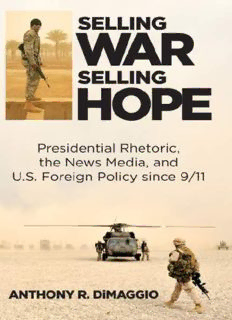
Selling War, Selling Hope: Presidential Rhetoric, the News Media, and U.S. Foreign Policy since 9/11 PDF
Preview Selling War, Selling Hope: Presidential Rhetoric, the News Media, and U.S. Foreign Policy since 9/11
Selling War, Selling Hope Selling War, Selling Hope Presidential Rhetoric, the News Media, and U.S. Foreign Policy since 9/11 Anthony R. DiMaggio Published by State University of New York Press, Albany © 2015 State University of New York All rights reserved Printed in the United States of America No part of this book may be used or reproduced in any manner whatsoever without written permission. No part of this book may be stored in a retrieval system or transmitted in any form or by any means including electronic, electrostatic, magnetic tape, mechanical, photocopying, recording, or otherwise without the prior permission in writing of the publisher. For information, contact State University of New York Press, Albany, NY www.sunypress.edu Production, Cathleen Collins Marketing, Kate R. Seburyamo Library of Congress Cataloging-in-Publication Data DiMaggio, Anthony R., 1980– Selling war, selling hope : presidential rhetoric, the news media, and U.S. foreign policy since 9/11 / Anthony R. DiMaggio. pages cm Includes bibliographical references and index. ISBN 978-1-4384-5795-6 (hardcover : alk. paper) ISBN 978-1-4384-5797-0 (e-book) 1. United States—Foreign relations—2001–2009. 2. United States—Foreign relations—2009– 3. Mass media and international relations—United States. 4. Communication in politics—United States. 5. Rhetoric—Political aspects— United States. 6. Political oratory—United States. 7. War on Terrorism, 2001–2009—Public opinion. 8. Arab Spring, 2010—Public opinion. 9. Public opinion—United States. I. Title. E895.D56 2015 327.73009'0511—dc23 2014043287 10 9 8 7 6 5 4 3 2 1 Contents List of Figures vii List of Tables xiii Acknowledgments xv Introduction: Presidential Rhetoric from September 11 to the Arab Spring 1 Chapter 1 The Rhetoric of Fear and Hope in Afghanistan 17 Chapter 2 Selling the Iraq War 59 Chapter 3 Failure: The Iraq War and the Declining Influence of Presidential Rhetoric 105 Chapter 4 An Iranian Threat? Recycling the Rhetoric of Fear and Hope 159 Chapter 5 From Fear to Democracy: Presidential Rhetoric in the Arab Spring 189 Chapter 6 Losing Control: Obama’s Rhetoric on Benghazi and Syria 247 vi Contents Conclusion 281 Afterword 291 Notes 305 Bibliography 391 Index 401 Figures Figure 1.1. Presidential Rhetoric and Support for Bush’s War on Terror (September 2001) 23 Figure 1.2. Public Attitudes on Terror Threats and Alternatives to War (October 2001) 24 Figure 1.3. Public Attention to War in Afghanistan (October 2001–February 2002) 24 Figure 1.4. Public Support for War after September 11 (October 2001–January 2002) 24 Figure 1.5. Political-Media Effects on Public Opinion of War on Terror (November 2001–January 2002) 25 Figure 1.6. Declining Support for War (December 2008– November 2009) 27 Figure 1.7. Public Attention to Afghanistan (March– December 2009) 28 Figure 1.8. The Interplay between Casualties, Reporting, and War Opposition, Afghanistan (2009) 29 Figure 1.9. Public Trust in Government over Time (1964– 2008) 30 Figure 1.10. U.S. Conflict in Afghanistan: Framing a Terrorist Threat (June–December 2009) 49 Figure 1.11. Framing Terrorism and Afghanistan in Cable News (June–December 2009) 50 vii viii Figures Figure 1.12. Public Support for Afghan War (October 2009– January 2010) 52 Figure 1.13. Media Agenda-Setting on Afghanistan: Attention to the War as a Function of Reporting (2009) 54 Figure 1.14. Mass Media and Public Opinion on the Afghan Surge (December 2009) 55 Figure 1.15. Growing Opposition to the Afghan War (December 2009–March 2013) 56 Figure 2.1. Coverage of Iraq and Weapons of Mass Destruction (June 2002–March 2003) 78 Figure 2.2. Cable News Reporting on Iraq and Weapons of Mass Destruction (June 2002–March 2003) 79 Figure 2.3. Coverage of Iraq, al Qaeda, and Terror (June 2002–March 2003) 80 Figure 2.4. Cable Coverage of Iraq, al Qaeda, and Terror (June 2002–March 2003) 81 Figure 2.5. A Secondary Democracy and Human Rights Narrative (June 2002–March 2003) 82 Figure 2.6. Democracy and Human Rights on Cable News (June 2002–March 2003) 82 Figure 2.7. Major Actors in News Stories on Iraq (September 2002–March 2003) 84 Figure 2.8. Major Actors in Cable News Stories on Iraq (September 2002–March 2003) 85 Figure 2.9. Public Perceptions of an Iraqi Threat (November 2002–March 2003) 92 Figure 2.10. Public Opinion on Military Action on Iraq (August 2002–March 2003) 92 Figure 2.11. New York Times Agenda-Setting and Support for Bush on Iraq (August 2002–March 2003) 93 Figure 2.12. Media Agenda-Setting on Iraq (September 2002– November 2003) 94 Figures ix Figure 2.13. Continuing Support for War with Iraq (April 2003–June 2004) 95 Figure 2.14. Public Attention to News on Iraq (September 2002–March 2003) 97 Figure 2.15. Mass Media Effects on Public Opinion of War (January 2003) 99 Figure 2.16. Mass Media Effects on Public Opinion of War (February–March 2003) 101 Figure 3.1. General Skepticism of the Iraq War (March 2003–March 2010) 111 Figure 3.2. Substantive Opposition to War (March 2003– July 2007) 112 Figure 3.3. Continued Opposition to War (2006–2013) 112 Figure 3.4. Coverage of Iraq Violence (June 2003–June 2007) 113 Figure 3.5. Cable Coverage of Iraq Violence (June 2003– June 2007) 113 Figure 3.6. Public Attention to Iraq (December 2003– April 2008) 114 Figure 3.7. Agenda-Setting Media and Opposition to War (June 2003–June 2007) 115 Figure 3.8. Media Coverage and Monthly U.S. Casualties (June 2003–March 2007) 117 Figure 3.9. Presidential vs. Democratic Political Actors in Iraq Reporting (December 2003–April 2008) 119 Figure 3.10. The Bush Administration’s Changing Rhetoric on Iraq (May 2003–May 2008) 121 Figure 3.11. Media Attention and the Capture of Saddam Hussein (December 2003) 123 Figure 3.12. WMD Fiasco and Mediated Opposition to War (February 2004) 126
Description: